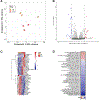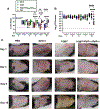Identifying genetic determinants of Streptococcus pyogenes-host interactions in a murine intact skin infection model
- PMID: 37889753
- PMCID: PMC10841832
- DOI: 10.1016/j.celrep.2023.113332
Identifying genetic determinants of Streptococcus pyogenes-host interactions in a murine intact skin infection model
Abstract
Streptococcus pyogenes is an obligate human pathobiont associated with many disease states. Here, we present a model of S. pyogenes infection using intact murine epithelium. We were able to perform RNA sequencing to evaluate genetic changes undertaken by both the bacterium and host at 5 and 24 h post-infection. Analysis of these genomic data demonstrate that S. pyogenes undergoes genetic adaptation to successfully infect the murine epithelium, including changes to metabolism and activation of the Rgg2/Rgg3 quorum-sensing (QS) system. Subsequent experiments demonstrate that an intact Rgg2/Rgg3 QS cascade is necessary to establish a stable superficial skin infection. QS cascade activation results in increased murine morbidity and bacterial burden on the skin. This phenotype is associated with gross changes to the murine skin and with evidence of inflammation. These experiments offer a method to investigate S. pyogenes-epithelial interactions and demonstrate that a well-studied QS pathway is critical to a persistent infection.
Keywords: CP: Microbiology; NZ131; RNA-seq; Rgg2/Rgg3; Streptococcus pyogenes; animal models; host response; quorum sensing; skin infection; transcriptome.
Copyright © 2023 The Authors. Published by Elsevier Inc. All rights reserved.
Conflict of interest statement
Declaration of interests The authors declare no competing interests.
Figures






Similar articles
-
Antagonistic Rgg regulators mediate quorum sensing via competitive DNA binding in Streptococcus pyogenes.mBio. 2013 Jan 2;3(6):e00333-12. doi: 10.1128/mBio.00333-12. mBio. 2013. PMID: 23188510 Free PMC article.
-
The Proteomic and Transcriptomic Landscapes Altered by Rgg2/3 Activity in Streptococcus pyogenes.J Bacteriol. 2022 Nov 15;204(11):e0017522. doi: 10.1128/jb.00175-22. Epub 2022 Oct 31. J Bacteriol. 2022. PMID: 36314832 Free PMC article.
-
A Streptococcus Quorum Sensing System Enables Suppression of Innate Immunity.mBio. 2021 May 4;12(3):e03400-20. doi: 10.1128/mBio.03400-20. mBio. 2021. PMID: 33947757 Free PMC article.
-
Quorum sensing in group A Streptococcus.Front Cell Infect Microbiol. 2014 Sep 12;4:127. doi: 10.3389/fcimb.2014.00127. eCollection 2014. Front Cell Infect Microbiol. 2014. PMID: 25309879 Free PMC article. Review.
-
Animal Models of Streptococcus pyogenes Infection.2022 Sep 5 [updated 2022 Oct 4]. In: Ferretti JJ, Stevens DL, Fischetti VA, editors. Streptococcus pyogenes: Basic Biology to Clinical Manifestations [Internet]. 2nd edition. Oklahoma City (OK): University of Oklahoma Health Sciences Center; 2022 Oct 8. Chapter 20. 2022 Sep 5 [updated 2022 Oct 4]. In: Ferretti JJ, Stevens DL, Fischetti VA, editors. Streptococcus pyogenes: Basic Biology to Clinical Manifestations [Internet]. 2nd edition. Oklahoma City (OK): University of Oklahoma Health Sciences Center; 2022 Oct 8. Chapter 20. PMID: 36479771 Free Books & Documents. Review. No abstract available.
Cited by
-
Interplay between group A Streptococcus and host innate immune responses.Microbiol Mol Biol Rev. 2024 Mar 27;88(1):e0005222. doi: 10.1128/mmbr.00052-22. Epub 2024 Mar 7. Microbiol Mol Biol Rev. 2024. PMID: 38451081 Free PMC article. Review.
-
Dual quorum-sensing control of purine biosynthesis drives pathogenic fitness of Enterococcus faecalis.bioRxiv [Preprint]. 2024 Aug 13:2024.08.13.607696. doi: 10.1101/2024.08.13.607696. bioRxiv. 2024. PMID: 39185165 Free PMC article. Preprint.
-
Streptococcus canis transcriptomic modifications in host cell entry environments of human keratinocytes.BMC Genomics. 2024 Nov 4;25(1):1028. doi: 10.1186/s12864-024-10974-z. BMC Genomics. 2024. PMID: 39497051 Free PMC article.
-
Global changes in Staphylococcus aureus virulence and metabolism during colonization of healthy skin.Infect Immun. 2025 Apr 8;93(4):e0002825. doi: 10.1128/iai.00028-25. Epub 2025 Mar 21. Infect Immun. 2025. PMID: 40116525 Free PMC article.
-
The Streptococcus pyogenes mannose phosphotransferase system (Man-PTS) influences antimicrobial activity and niche-specific nasopharyngeal infection.J Bacteriol. 2025 Apr 17;207(4):e0049224. doi: 10.1128/jb.00492-24. Epub 2025 Mar 26. J Bacteriol. 2025. PMID: 40135874 Free PMC article.
References
Publication types
MeSH terms
Substances
Grants and funding
LinkOut - more resources
Full Text Sources
Molecular Biology Databases
Miscellaneous

